| Previous Unloads: | |
|
1991 May: A Visit to Langkawi, the Land of Mahsuri 1991 Aug: Study tour to Medan, Indonesia 1994 May: First Asia Pacific Chitin and Chitosan Symposium (APCCS) 1995 Dec: Revisiting SAS 1997 Dec: Rally Nationwide Vision 1998 Apr MOU and Launching of Chito-Chem (M) Sdn Bhd 1999 Sep: The Officiation of Smart Technology Centre, UKM 1999 Sep 23: A Week on Leave 1999 Dec: Study Tour to Taiwan |
2000 Jul: A MiniReunion of Class of 66 2000 Dec: Just An Unlucky Day 2001 Jul: 29th Covocation of UKM 2001 Dec: Digging Deep Into the Root: SKBT Revisited 2002 Sep: A Consequential Events from Feb 2002 2003 Apr: Reminiscing the Little Boy 2003 Nov: Reunion of Class of 66 2004 May: Cameron Highland Revisited 2004 Jul: In the Heart of Two Cities |
In the Heart of Kuala Lumpur and Penang (Dated: Jul 2004)
| I stay in Sungai Merab, near Bangi, south of Kuala Lumpur; "migrated" from my home town Terengganu since 1967 when I came to KL for my form 4 in Sekolah Alam Shah, Cheras. KL thus is my current "home", and is where I continued to grow up. I started my family in KL although my wife is also from my home place. In Jul 2004, my job took me for a few days to the place in KL where I was for the first time, begining Jan 1967, to be bonded for years to come; it was in the heart of KL city. The job was a continuation from one of the previous week, also in the heart of a city, another city; a city where I felt I began my first flap of wings in Jul 1973, for "take off" in the following years to come; it was in the heart of Penang. The fate had taken me to these two 'distant' places, amazingly in one simultaneous time. | ||
| In the Heart of Modernised Old KL | In the Heart of Modernised Old Penang | |
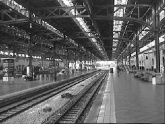 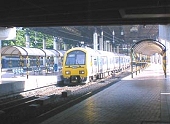
I deliberately 'travelled' to KL this time by rail (KTM komuter) so that I could reminisce with Stesen Kuala Lumpur, because I would disembark from here to my hotel. I had passed several times this station in recent years, but never disembark from here. In 1970's I felt the station was very big, alas, it had only two double tracks, thus four platforms, but with subways to move safely from a platform to another. With the KL Central operational in 2001 April 16, which rendezvous all trains and other rail transitters, Stesen Kuala Lumpur dwindled to just a transit for the original 'owner', Keretapi Tanah Melayu (KTM) for its Komuter. My first cue at this station was in 1967 April 30 Sun morning, arriving from Kota Bharu, Kelantan, on our return to SAS after the first term break, deliberately by rail; and that was my first travel by rail. Then another one in 1970 April 2 Thu night, sending-off schoolmates, then in 1974 Feb 14, and another April 4 on a travel with Azahari Salleh to his parent place in Singapore, then it became irrelevant.
 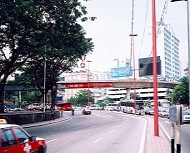
Malayan Banking HQ was the tallest building in KL in the 1970's, erected from the foot of a hill on which stood the Menara Telekom (now become Telekom Muzeum); it was then dwarfed by others sooner than expected. The opposite side evolved congrously; new buildings added or renovated, but essentially the businesses are the same. Pudu Road (then was just a single lane dual carriage ways) leads to Bukit Bintang Road junction with its notorious BB amusement park; but this place was very alien to me until only recently: when IT hub was put up in Imbi Plaza (1990's) and Low Yat plaza (2000's); Sungai Wang plaza was an "onlooker". I even got lost here one early morning (Nov 5, 1996) to locate the Federal Hotel at the Bukit Bintang Rd junction. Pudu Road was also the gate out to KL from Dewan Bahasa, which I was not very frequent in the 70's, but very much so in the late 80's onward. 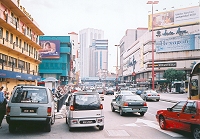 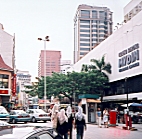
Foch Ave (now known as Jalan Pudu from the renamed Jalan (Tun Tan) Cheng Lock when it was confused with one in Melaka) was the KL I first set foot on; it was in the morning of Jan 21 Sat 1967, two days after my arrival in SAS, sneakingout with my state-mate Ismail Mohd, not knowing that on that day there was a prep class in the school. When we returned in the afternoon, the class was over, and perhaps no one noticed that we had been to KL in the morning (instead of from afternoon). On this very first trip, I took the bus, the Tong Fong #101, 16 cents fare, which dropped us on the left side of the road. There were sundries shops on both sides of the road, but on the right side the shops were more of make-shift stalls operated by small petty traders. In one of these shops I bought a small black-yellow-red stripes towel (I did not have a towel before) which would also be used as my praying mat on Friday, and a pair of 'soft' shoe which would be specifically used when the PE was in the gymnasium (ordinary shoes such as Bata's badminton master were not allowed by Mr Tan Pock Chin the PE teacher). On this very first trip to KL also I noticed the very many chinese which I had not seen so many of them before and behaved so alien unlike the chinese in Terengganu; and the indian petty traders too. For many moments I felt that I was not in my own country. I learned to speak chinese-indian-dilect Malay (unlike in Terengganu where the chinese and indian spoke terengganu-dilect Malay; and in Terengganu a chinese never spoke in chinese to another chinese infront of a Malay, they spoke in Malay, so that all three could understand each other). For the first two years, my loci was only around these places including those at the back; those of Leboh Pasar area on the way to Melaka St. The gov dental hospital is still there; my last visit here was on Sep 25 Fri 1970 for a molar extraction. At the Mydin Wholesaler was a few very big trees of a back street. Along this street Tong Fong bus picked up the passenger; SASians were waiting for #101 which took us to Cheras, then a long walk to SAS; but the #101 with a red plaque at the bottom of the windshield, it took us direct to the school, right infront of the hall. On the right side of Foch Ave was a dept store, Isetan. It had apparently disappeared (and reappeared near KLCC); and Kota Raya took the site. 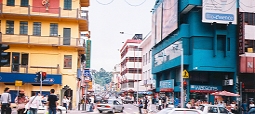  Jalan Sultan, off the Foch Ave, a street encircling an area of what evolved to be known as 'china town'. On the right side was Rex cinema. 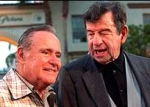 I had been to this cinema a few times: one in late afternoon Jan 3 Sat 1970 when Alias Yusof and I were trapped by the rain and he insisted on watching Jack Lemon and Shirly McClain in Irma la Douse. But the real attraction was the accompanying documentry Intimate Report which was about the sex revolution in the US and the explicit graphicals of human evolution from inception to birth. To this date I am a fan of Jack Lemon, and obviously his ever-perfect partner Walter Matthau. I had been to this cinema a few times: one in late afternoon Jan 3 Sat 1970 when Alias Yusof and I were trapped by the rain and he insisted on watching Jack Lemon and Shirly McClain in Irma la Douse. But the real attraction was the accompanying documentry Intimate Report which was about the sex revolution in the US and the explicit graphicals of human evolution from inception to birth. To this date I am a fan of Jack Lemon, and obviously his ever-perfect partner Walter Matthau.
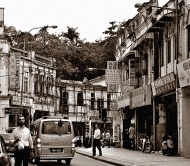 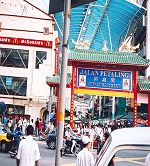
The one and only Petaling Street, together with Jalan Sultan and Foch Ave formed the triagularly china town in Kuala Lumpur: the place in the 70's harboured only the chinese; scaring the others on many times to go there. But it was china town shopping area. Nonetheless I had been here several times. The first time was unintentional, I did not even know that it was Petaling St, and its reputation. 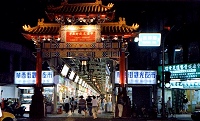 It was 1970 Feb 13 Fri after mid-day when nowhere to take I took Chairul the younger brother of a newly arrived Indonesian teachers in temporary 'depot' in STTI. While we were walking along the road I noticed a sudden choatic run of the traders. I was scared and pulled Chairul back to Foch Ave to get the bus back to SAS. Apparently the traders were running to save their goods because Bandaran KL was on his way to sweep the 'illegal' traders. Then again in 1973 Apr, when I needed to buy a tortoise for research (when I was an RA of Dr Noramly and Gary Waagen). Then two times in 1977 when I took Azizah for a window shopping. Recently half of the street (cutting off at Jalan Sultan - leaving the other half in its original state) was internationally decorated for tourist; it was like a duplicate of Taipei's Tourist Night Market which I visited in Dec 1999. It was 1970 Feb 13 Fri after mid-day when nowhere to take I took Chairul the younger brother of a newly arrived Indonesian teachers in temporary 'depot' in STTI. While we were walking along the road I noticed a sudden choatic run of the traders. I was scared and pulled Chairul back to Foch Ave to get the bus back to SAS. Apparently the traders were running to save their goods because Bandaran KL was on his way to sweep the 'illegal' traders. Then again in 1973 Apr, when I needed to buy a tortoise for research (when I was an RA of Dr Noramly and Gary Waagen). Then two times in 1977 when I took Azizah for a window shopping. Recently half of the street (cutting off at Jalan Sultan - leaving the other half in its original state) was internationally decorated for tourist; it was like a duplicate of Taipei's Tourist Night Market which I visited in Dec 1999.
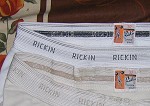 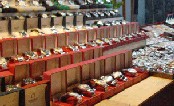 Everything sold in the stalls are faked products (except the fruits), the shoes, the shirts, bags, perfumes, dresses, including the underwear, and especially the watches of all the super-brands. Some pirated CDs are sold in faked CD-R. Like in Batu Feringgi in Penang, here Islam is welcomed in the form of Arabs (many women in black veils) tourists who do not ask very much about the price when they like the items. Everything sold in the stalls are faked products (except the fruits), the shoes, the shirts, bags, perfumes, dresses, including the underwear, and especially the watches of all the super-brands. Some pirated CDs are sold in faked CD-R. Like in Batu Feringgi in Penang, here Islam is welcomed in the form of Arabs (many women in black veils) tourists who do not ask very much about the price when they like the items.
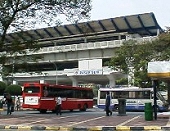 At the end of Foch Ave is the Jalan Sultan Mohamad bus station which handled mostly Sri Jaya buses to PJ, Klang and eastward to Batu Road and Kg Baru. For the first three years of my tenure in SAS I did not know this place, even if I wanted to go to Batu Rd, I walked from Foch Ave through Leboh Pasar and Malacca St; to my seniors (as they were talking about it) this was the place to take the bus to Jalan Hale Kg Baru to visit the girls in their hostel. Apparently it was not a quite distance from Foch Ave where they dropped from Tong Fong bus. At the end of Foch Ave is the Jalan Sultan Mohamad bus station which handled mostly Sri Jaya buses to PJ, Klang and eastward to Batu Road and Kg Baru. For the first three years of my tenure in SAS I did not know this place, even if I wanted to go to Batu Rd, I walked from Foch Ave through Leboh Pasar and Malacca St; to my seniors (as they were talking about it) this was the place to take the bus to Jalan Hale Kg Baru to visit the girls in their hostel. Apparently it was not a quite distance from Foch Ave where they dropped from Tong Fong bus.
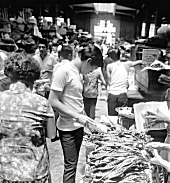 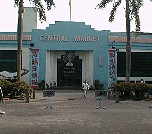
Facing Jalan Sultan Mohamad bus station is Central Market, which had been turned to Pasar Seni. It was a wet market since 1936 (said to be previously former 24-hrs gambling den of Yap Ah Loi, the chinese kapitan) for Kuala Lumpur creatures selling all the commodities for the households until 1986 when it was changed to an arts and craft market. I had been here only once, in 1970, to buy some green lemons. The stall owner gave me some tips on how to choose juicy lemons. I went there again on Jul 30 Fri 2004 to have the famous central market nasi kandar, with Dr Razak Ali of UTM. Today, central market is more associated with the LRT station, from where the rail started it underground route to KLCC.  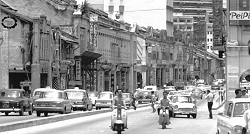
Only in my third year (1969), I extended my loci to Batu Rd, its end Chow Kit Rd, and the parallel Malay St, and later in 1970, Jalan Hale, Kg Baru. The school made the prefect's blazer at Wing Cheong tailor, 62 Batu Rd, which I was very deliriously happy to have one eventhough it took 62 ringgit (more than a month) of my scholarship money. I visited the famous Kg Baru Sunday Market only in 1970; and that was partly because of my presence at the nearby SAS girl hostel. |
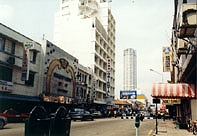 Penang Road and Peking Hotel on the right. My first trip to Penang was on Sun 1973 Jul 22 (amidst the beutiful stories about Penang from my schoolmates in SAS and UKM) in UKM Chemistry Dept students study tour organised for the Dept by Dr Ramlee Karim. We stayed in Peking Hotel for the night before touring Eastern Trading Co and Malayawata the following day in Butterworth and Prai industrial area. Penang Road did not set in my memory until recently when I knew that it was in Penang Rd that I put-up in 1973. There was no KOMTAR yet. Penang Road and Peking Hotel on the right. My first trip to Penang was on Sun 1973 Jul 22 (amidst the beutiful stories about Penang from my schoolmates in SAS and UKM) in UKM Chemistry Dept students study tour organised for the Dept by Dr Ramlee Karim. We stayed in Peking Hotel for the night before touring Eastern Trading Co and Malayawata the following day in Butterworth and Prai industrial area. Penang Road did not set in my memory until recently when I knew that it was in Penang Rd that I put-up in 1973. There was no KOMTAR yet.
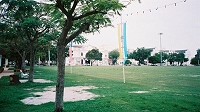 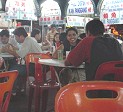
But Padang Kota was. We sort of enjoyed our meal in Padang Kota (food bazaar like we had in KL in Medan Selera in Section 14 and Benteng at Lebuh Pasar). Of all the meal I picked was the fried crab which was wooden-hard. I did not pay much attention to nasi kandar because then I understood that nasi kandar was just a nasi campur (in Terengganu it was called nasi Malaya - obviously the taste is different). We went (walked) to Padang Kota at night, so I did not know what were around it; and we left Penang the first thing in the morning. 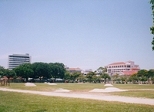 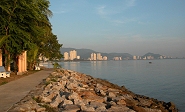 Apparently Padang Kota was a peripheral of the heart of Penang. There were many British relics around it and were preserved to this day to become the objects of elderly white tourists: the esplanade, city hall, magistrate court, fort cornwallis, (and lately) Dewan Sri Pinang, etc (incidently also very close to the objects of young white tourists in Leboh Chulia, the Garage and the surrounding area); and the place was not very far from the sea-front. Today this Padang Kota was named Padang Kota Lama; only a handful of food stalls remained in a rebuilt cleaner corner. The rest was converted to green field for festive occasions normally congruously with such in the nearby Dewan Sri Pinang. But the spirit of Padang Kota is still alive. It was taken to Gurney Drive facing the Penang Bay which was renamed Padang Kota Baru. On this occasion I stayed in the hotel visible at the end of the street on the right picture below; with the revolving coffee house. 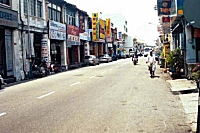 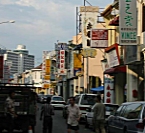
I remembered on the way back from Padang Kota, along the Leboh Chulia in Jul 1973, I stopped in a watch shop and bought a citizen automatic for a 65RM to replace the one I was wearing, a seiko "manual" which I bought from my cousin Mokhtar in 1971 just before I checked-in UKM to replace my 1967 Timex which had stopped ticking. The watch was good; it was on my wrist through to 1980, survived twice of my tennure in England when it was replaced by another citizen digi-analog in Manchester, which in turn was burglered in 1988 Jan 3 Sun early AM hrs, in my home in Sg Merab. I felt I missed my citizen-auto, so on my visit on Nov 24 1994, I bought a seiko 5-auto instead and in Penang Rd. It did not quite relief because it late a minute every day, and the watchsmith said it can not be rectify. During Jul 2004 visit however, I bought a citizen-Q, perhaps in the same shop as seiko-5, but for my daughter #5, who by then deserved a real watch for her PMR, as I did for my daughters #1 and #2. 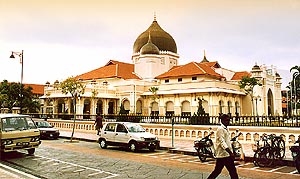 Kapitan Kling moaque at the end-off the Leboh Chulia, was not an item in my visit in 1973 although it was very much a land mark of Penang. But I had prayed once in the evening in my casual visit with my family in 1990 Nov 8. 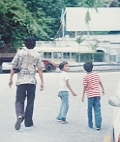 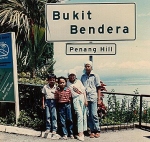 
During this visit also, for the first time, I took the Bukit Bendera (Penang Hill) rail, an attraction very much publicised by my Penangite schoolmates, and after the ride, I thought I would not go again. I got scared to the steepness of the rail, and the view as though the rail was suspended rather than rested on the ground. My wife and my sister made a right pre-decision not to climb. 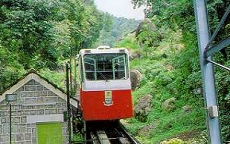 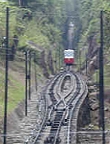
I was looking for a view of two opposing trains on this exact middle of the track, a view I remembered when I was reading about Penang Hill when I was in primary school in early 60's which looked like a thick book being opened in the middle. Obviously I could not. 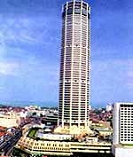 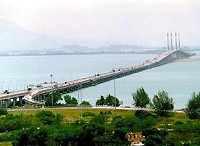 KOMTAR, completed in 1985, and The Bridge, completed in 1988, are objects of modernised Penang. My first visit to Komtar was in 1994 Nov 24 (for a short stop on the way home after delivering a paper in a conference in Batu Ferringgi). The public accessible areas of the Komtar (the first four floors) now dwindling; people had turned to better places in Bayan areas and other areas; it turned into an infinitesimal matter compared to such in KL. The bridge, I heard about it closer (apart from the media) when I was in Bukit Mertajam for the wedding of PakMat in 1985 Oct 19 that the folks in the area were very proud after returning from a journey of going on the bridge. Perhaps they would not purturb by the toll that would be installed because they had used to paying for the ferry. They were smilingly unaware that soon they were going to pay for riding the road too. KOMTAR, completed in 1985, and The Bridge, completed in 1988, are objects of modernised Penang. My first visit to Komtar was in 1994 Nov 24 (for a short stop on the way home after delivering a paper in a conference in Batu Ferringgi). The public accessible areas of the Komtar (the first four floors) now dwindling; people had turned to better places in Bayan areas and other areas; it turned into an infinitesimal matter compared to such in KL. The bridge, I heard about it closer (apart from the media) when I was in Bukit Mertajam for the wedding of PakMat in 1985 Oct 19 that the folks in the area were very proud after returning from a journey of going on the bridge. Perhaps they would not purturb by the toll that would be installed because they had used to paying for the ferry. They were smilingly unaware that soon they were going to pay for riding the road too.
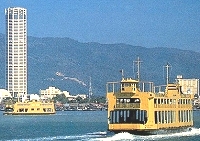 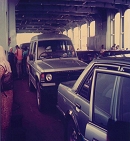
The Ferry, although had been equally very much publicised by my Penangite schoolmates, did not get very much of my attention in Jul 1973 because I lived with the word "ferry" since my childhood in Terengganu until I left for KL in Jan 1967 except for the size and its "modernness" compared to the one I used to. Nontheless when I took my kids out for a vacation-cum-survey on Chitin project to the north, in 1991 May 28 Tue I crossed to the island on the ferry, for their thrill. 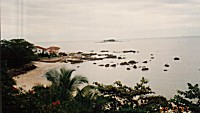 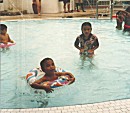
Tanjung Bungah, sound like 'indianish' or 'chinaish' of the malay name Tanjung Bunga, was a nostalgic name I heard as far back in the 70's, perhaps because it was in lyrics of many seriosa. I had a glimpse of it only as recent as in May 1991 on a stop en route to Langkawi. It was, as in the UK, a sea-front, when combined with the Gurney Drive which was renamed Padang Kota Baru. Since then I had been there twice, on loan to DBP workshops (1996 Aug 19-24, 1997 May 13-22), and once with the kids at Dec end 1997. 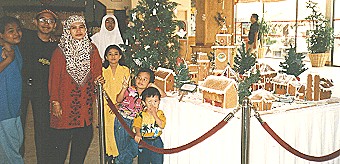
Further up is Batu Feringgi, which initially was out of my world apart from the word "feringgi" which means "Portugese", perhaps because of the shape of the stones on the beach which were more or less had portugese tuban-shape (like those worn in 1500's when they came to South East Asia). My first arrival at Batu Feringgi was in 1994 Nov when I was asked to give a scenario on the chitin research in a regional conference. Then Batu Feringgi was developed into a tourist paradise; many parts were untouchable by the locals, although the land side of the area are still inhabitated by the locals (who then in a highly constraint to maneuver - as against before when the beach side was actually their sites for fishing going), the beach side are full of high-rise and international hotels, resorts and all sorts. 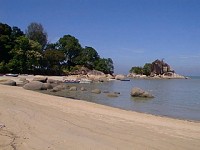 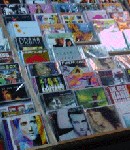 Like Petaling Street, and Bintang Walk in KL, Batu Feringgi is perhaps the only place in Penang where Islam is welcomed, in the form of Arab tourists who lately flocked Malaysia. In many stalls, I saw many writings were already in Arabic (jawi - unlike in other places in Malaysia where the jawi writing of the street name would sometimes suffered the fate of being sprayed with black paint); and some stall owners (mostly chinese) began to learn some strategic arabic words like "shukran" (when the money had been kissed good-bye and changed hand). And lately Batu Feringgi is known for a place which sells faked watches, of all the super-brands; but to a less extent than in Petaling Street. It is fascinating to see how the price is tagged and how its item is sold. One watch may be tagged for RM800, and it was sold for only RM40. Like Petaling Street, and Bintang Walk in KL, Batu Feringgi is perhaps the only place in Penang where Islam is welcomed, in the form of Arab tourists who lately flocked Malaysia. In many stalls, I saw many writings were already in Arabic (jawi - unlike in other places in Malaysia where the jawi writing of the street name would sometimes suffered the fate of being sprayed with black paint); and some stall owners (mostly chinese) began to learn some strategic arabic words like "shukran" (when the money had been kissed good-bye and changed hand). And lately Batu Feringgi is known for a place which sells faked watches, of all the super-brands; but to a less extent than in Petaling Street. It is fascinating to see how the price is tagged and how its item is sold. One watch may be tagged for RM800, and it was sold for only RM40.
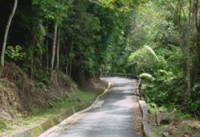 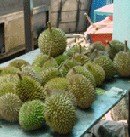
During my visit in May 1997, I proceeded to Balik Pulau, and negotiated the hills road for the famous durian. I found it and devoured with my #4 Muzani and a colleague Amran Joned of DBP. Believe it or not, three of us could not finish one fruit. The next day, on our way home, we revisited the orchard to buy a few for the kidies at home. It happened that it was raining during the night, and what a lucky day, the owner said the price fall to half, at RM3 per kilo, because of the rain. |
|
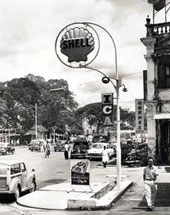
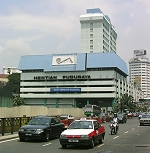
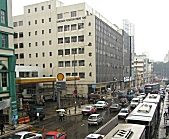 In the late 1960's this bus station handled those shuttling to the south. The prominent bus was the Foh Hup (whose drivers were infamous for daring speeding) which served for the passengers to Kajang and Seremban, and the express buses to Melaka and Johor. The ticketing "offices" were more like stalls. The loading and unloading areas were not tarmac, but were on coarse ground. Taxis and trishws were webbing among the passengers, padestrians; so did the petty traders with all kinds of sundries. A few big trees provided ranges of shdows to comfort the heated waiting passengers.
In the late 1960's this bus station handled those shuttling to the south. The prominent bus was the Foh Hup (whose drivers were infamous for daring speeding) which served for the passengers to Kajang and Seremban, and the express buses to Melaka and Johor. The ticketing "offices" were more like stalls. The loading and unloading areas were not tarmac, but were on coarse ground. Taxis and trishws were webbing among the passengers, padestrians; so did the petty traders with all kinds of sundries. A few big trees provided ranges of shdows to comfort the heated waiting passengers.